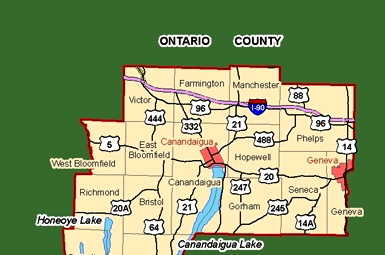Early Ontario County History

A line drawn due north and south through New York State, touching the west shore of Lake Seneca, will mark the eastern boundary of the original county of Ontario as it was in 1789. All the State west, now divided into fourteen counties, was simply parts of Ontario. It was a territory greater than most European countries; a region that in the beneficent combination, soil, water and climate, has seldom been equaled. Ten years earlier it was peopled by Indians, the Senecas, of the great confederacy of the Iroquois; only the trader and trapper knew much concerning it. Sullivan had penetrated parts of the district with his punitive army in 1779; the French and English had wandered through segments of it, erected a few forts, established a few puny settlements on the outskirts; but as a whole, Ontario was a virgin territory.
In December, 1786, a section which included the present counties of Ontario, Steuben, Genesee, Allegany, Niagara, Chautauqua, Monroe, Livingston, Erie, Yates, and the western halves of Orleans and Wayne, were turned over to the State of Massachusetts, subject to the claims of the Seneca Indians. In July, 1788, Oliver Phelps secured the Indian title, and in November of the same year Mr. Phelps and Nathaniel Gorham bought the Massachusetts rights of the eastern sector.
The first act of the owners was to find the proper place for their headquarters in their domain and create a settlement. William Walker, as their agent, entered the wilderness to find the site of the Indian village of Kandesaga at the foot of Lake Seneca, and survey the lines of the projected village. Phelps meanwhile was informed that there had been a mistake in the marking of the Preemption Line, which would place his proposed settlement on lands not his own. He, therefore, hurried word to Walker, “you had better make ye outlet of Kennadargua Lake your headquarters, as we mean to have you rule independent of any one.”
The following year, 1789, the son of Mr. Gorham, accompanied by General Chapin and others, came to the later chosen location and became the pioneers of the town of Canandaigua and the founders of the present county of Ontario. The village which they developed became the headquarters of the company, the seat of the first land office in the western part of the State, and the shire town of the eventually greatly reduced Ontario County.
Phelps and Gorham were unable to find the means to pay their obligations and disposed of all the unsold lands to Robert Morris, in August, 1790, who shortly after parted with them to an English syndicate, represented by Charles Williamson, who aided greatly in the development of the district.
Ontario County, as now constituted, has an area of 640 square miles left from its original 6,000,000 acres. It has been a true “Mother of Counties.” In 1796, Steuben was set off; in 1802 all the land west of the Genesee was taken. So rapidly had the country been settled that, even after the loss of Steuben, she had more than 10,000 inhabitants, and when the tremendous county of Genesee had been separated, she had as many residents as a few years previously there had been in the whole western part of New York. In 181O, the comparatively small section of Ontario left was credited with a population of 42,000. In 1821, both Livingston and Monroe were born; in 1823 Ontario gave areas to Yates and Wayne; the boundaries established then are those of the present. Ontario has been the mother of six children; her total descendants now number fourteen.
The county, even when it covered the original territory, was recognized as one particularly suited to agriculture, especially that part now enclosed in Ontario. Col. Hugh Maxwell, who had charge of the early surveys, wrote to his wife in Massachusetts that the country exceeded his expectations “in richness of soil and pleasantness of location …. the land in this country is exceedingly good.” The pioneers came as farmers, and as such were not slow in developing the natural resources of the district. Abner Barlow, at his place in Canandaigua, in 1790, harvested the first wheat grown in the Phelps and Gorham Purchase. The present Ontario has never been led away from its first love; it is today the premier grain growing county in the State. There was one other section (1920) that exceeded it slightly in wheat, but in the growing of barley it ranks first, and the large amounts of other cereals harvested brings its total to higher figures than any other county. But it is not a one crop region, or even simply a grain country. The potato crop comes eighth among the divisions of New York; in small fruits it is fourth; grapes, fifth. All the orchard fruits are grown, cherries being one of the specialties, in the production of which it is fourth.

